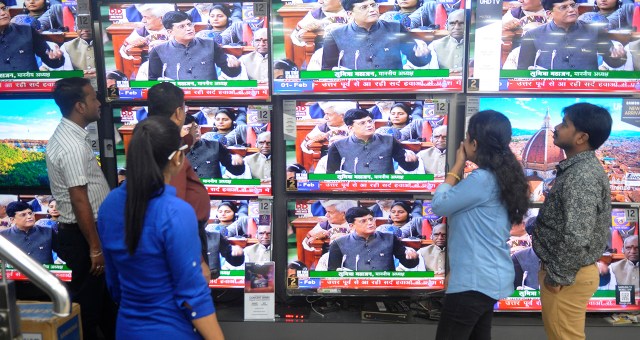
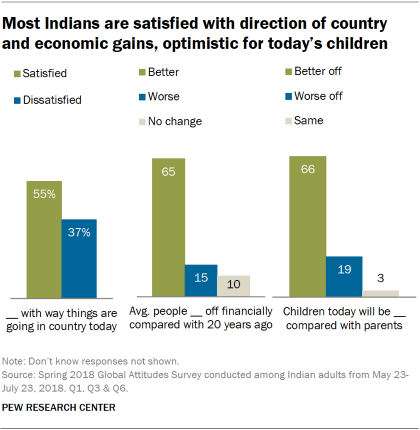
Polls are about to open to as many as 900 million people in the world’s largest democracy. The elections follow a year in which most Indian adults showed dissatisfaction with the nation’s progress on issues including unemployment, inflation and the efficacy of elections. Even prior to the Pulwama attack in Indian-administered Kashmir, majorities of Indians voiced concern about terrorism and the threat posed to their country by Pakistan. But despite these worries, most Indian adults are satisfied with the direction of their country and the economic prospects of the next generation, according to a Pew Research Center survey conducted among 2,521 respondents in India from May 23 to July 23, 2018.
Here are 12 takeaways about public opinion in India that provide context about the public’s views leading up to the national elections.
Indian public opinion on national conditions
Indian adults certainly recognize that their personal economic well-being has benefited greatly from strong national economic performance: Indian economic growth has averaged 7.3% per year since 2014. Roughly two-thirds (65%) say the financial situation of average people in India is better today than it was 20 years ago. Only 15% say things are worse.
But there are signs of public unease. About two-thirds of Indians (66%) believe that today’s children will be better off than their parents. But that optimism is down 10 percentage points since 2017.
Similarly, a majority of Indians (55%) are happy with the way things are going in their nation today. But that is down 15 points from 70% in 2017 and marks a return to the level of public satisfaction in 2015, the first full year of Narendra Modi’s government. Still, Indians’ mood remains much higher than in the last two years of the previous government of Manmohan Singh.
Lack of employment opportunities is seen by the public as India’s biggest challenge, with 76% of adults saying it is a very big problem – little changed over the past year. In 2018, despite an estimated 3.5% formal unemployment rate, 18.6 million Indians were jobless and another 393.7 million work in poor-quality jobs vulnerable to displacement, according to estimates by the International Labor Office.
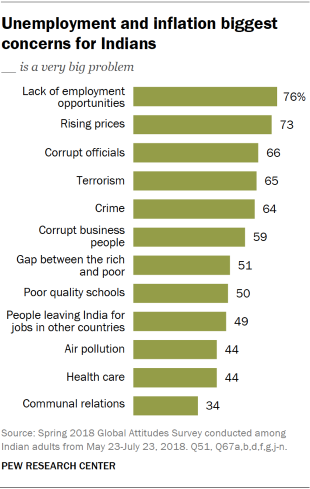
Other aspects of the economy are also at the top of the public’s concerns. More than seven-in-ten (73%) believe rising prices are a very big problem.
About two-thirds of the public says corrupt officials (66%), terrorism (65%) and crime (64%) are very big problems. In each case, such concern is down significantly from 2017 – by 20 percentage points in the case of crime, 11 points for terrorism and 8 points regarding officials’ corruption.
Indians with at least a secondary education are significantly more worried about corrupt officials than the less educated. Notably, there is little partisan difference in views of these problems.
On one very personal aspect of crime, more than half (54%) of Indians say the statement “most people live in areas where it is dangerous to walk around at night” describes India very or somewhat well.Roughly half of the public believes the gap between the rich and the poor is a very big problem (51%) and a similar share complains about poor-quality schools (50%). But while the latter sentiment has not changed since 2017, concern about inequality is down 10 points. More than four-in-ten are very concerned about air pollution and health care (both 44%), but these views are also down 10 points.
Notably, incidents of communal violence are higher than they were in 2014, according to Indian Ministry of Home Affairs data, but only about a third of Indians (34%) see this as a very big problem facing the country.
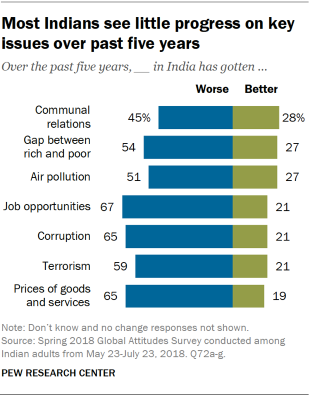
When asked whether various challenges facing India have gotten better or worse in the past five years, a time frame that largely encompasses the term of the current Modi government, few Indians voice a positive judgment. Just one-in-five (21%) say job opportunities have gotten better, while 67% think things have gotten worse (including 47% who say much worse). A similar share believes prices of goods and services (19%), corruption (21%) and terrorism (21%) have gotten better.
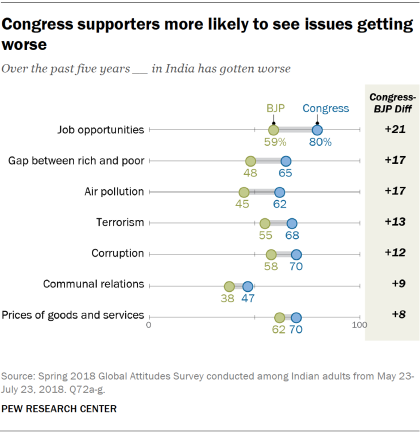
Meanwhile, 65% say prices have gotten worse, 65% are of the opinion that corruption has worsened (including again 47% who say it is much worse) and 59% think terrorism is worse. (This survey was conducted roughly nine months prior to the Pulwama attack, later claimed by Pakistan-based terrorist group Jaish-e-Mohammad.) Roughly one-in-four think the gap between the rich and the poor has narrowed (27%) and that air quality has gotten better (27%). In both cases, more than half the public thinks these things have gotten worse. And just 28% say communal relations have improved, while 45% say they have gotten worse.
As the Lok Sabha election nears, there is a decidedly partisan take on the direction of the country and the challenges facing India. Members of the opposition Indian National Congress party (Congress) are 21 percentage points more likely than backers of Prime Minister Narendra Modi’s Bharatiya Janata Party (BJP) to say that job opportunities have worsened and 17 points more likely to say the same about air pollution. Congress adherents are more likely than BJP supporters to believe inequality has gotten worse (by 17 points), that corruption has worsened (12 points) and that terrorism and communal violence has become more of a problem.
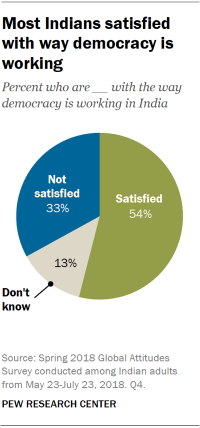
As Indians head into election season, more than half (54%) are satisfied with the way democracy is working in their country. However, satisfaction has declined 25 percentage points from 2017, when 79% voiced approval. Men are more likely than women to give Indian democracy a thumbs-up, though one-in-five women decline to offer an opinion. Indians with a secondary education are more likely than those with less than a secondary education to be satisfied with their democracy, though one-in-six (17%) less-educated Indians offer no opinion. Such satisfaction is a partisan affair: 75% of BJP supporters, but only 42% of Congress adherents, are satisfied with how Indian democracy functions.
In April and May 2019, Indians will go to the polls to elect a new Lok Sabha, the 545-seat lower house of the Indian Parliament. Roughly 900 million people are eligible to vote. When it comes to specific aspects of their democracy, Indians voice strong frustrations about elections and elected officials.
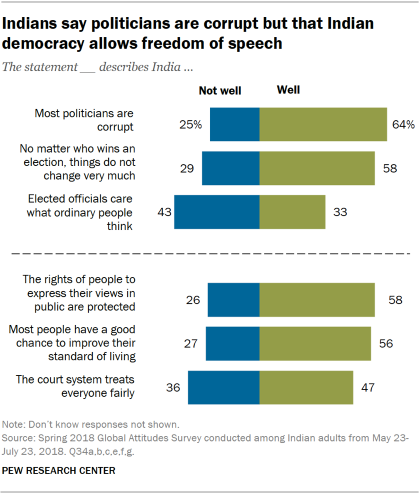
Nearly two-thirds (64%) say most politicians are corrupt (including 43% who very intensely hold this view). Notably, nearly seven-in ten (69%) of both BJP supporters and Congress backers share the view that elected leaders are corrupt.
Another 58% voice the opinion that no matter who wins an election, things do not change very much. This includes a majority of both BJP and Congress adherents.
And only 33% of Indian adults believe elected officials care what ordinary people think. Men are more likely than women to believe that officials don’t care, but almost a third of women (32%) decline to voice an opinion.
At the same time, the public thinks that the Indian state allows democratic values to flourish.
By more than two-to-one (58% to 26%), Indians say their rights to express their own views are protected very or somewhat well. Those with more education are more likely than those with less education to say freedom of speech is protected, although, again, a significant share of the less educated (22%) voice no opinion.
A similar proportion (56% to 27%) says most people have a good chance to improve their standard of living in India. People living in urban areas are more likely than those in rural parts of India to believe in such opportunities. BJP supporters (66%) are more likely than Congress adherents (53%) to say Indian democracy delivers economic opportunity.
A plurality (47%) believes the court system treats everyone fairly, a perception held especially among young people.
Globalization and India
Indians (71%) overwhelmingly believe trade is good for their nation. Support for trade, in principle, is roughly comparable to that in Japan (72%) and the United States (74%), but lower than that in the European Union (85%), according to a recent international survey by Pew Research Center. And the share of Indian adults who say growing trade and business ties between India and other countries is very good has nearly doubled, from 25% in 2014 to 49% in 2018.
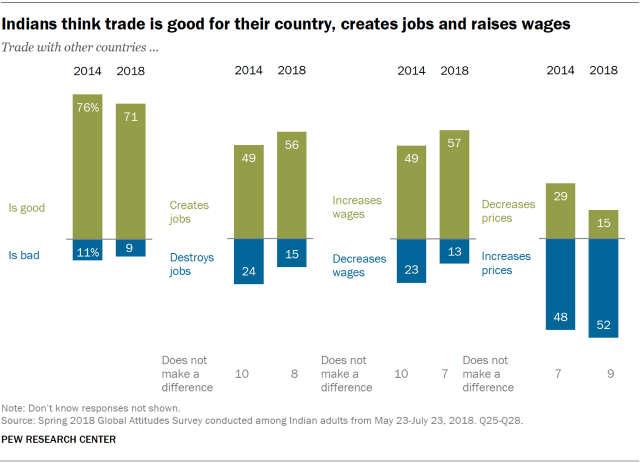
The rise in intense Indian support for trade reflects a widely shared perception that international commerce benefits individuals. Contrary to public opinion in the U.S., Europe and Japan, a majority of Indians believe trade with other countries leads to an increase in wages (57%) and creates jobs (56%). And such sentiment is up slightly from 2014. Few Indian adults believe trade kills jobs (15%) or undermines wages (13%). At the same time, roughly half of Indians (52%) say trade increases prices, a sentiment that is widely shared in other emerging markets yet is contrary to economic theory that international commerce should lead to falling prices.
Educational attainment plays a role in Indian views of trade. Of those who offer an opinion, adults with at least a secondary education are far more likely than those with less education (86% vs. 63%) to say that trade is good for India. They are also more likely to believe that trade creates jobs (72% vs. 49%) and boosts wages (71% vs. 50%), but also to think that trade leads to higher prices (65% vs. 46%). Less-educated Indians are roughly three times as likely as more educated Indians to voice no opinion about the impact of trade, highlighting the significance of education in shaping public views of globalization.
For those who provided a response, there is also a generational difference in public opinion about the impact of globalization. Young Indians, those ages 18 to 29, are more likely (59%) than older Indians, those ages 50 and older (50%), to believe that trade generates new employment. And young Indians (55%) are more likely than their elders (45%) to say trade raises prices. Older Indians are, however, more likely than their younger compatriots to have no view, or less willing to share that view, on the personal impacts of trade.
BJP supporters are more likely than Congress backers to think trade creates jobs and raises wages, but they are also more likely to believe that trade raises prices.
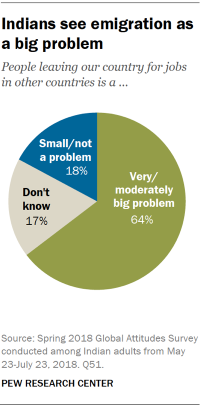
With more than 1.35 billion people, India is home to the world’s second-largest population and nearly a fifth of the total world populace. India also happens to be the top source of international migrants – one-in-twenty migrants worldwide in 2015 were born in India. In 2017 more than 16 million Indians were living abroad, with high concentrations in the United Arab Emirates, the United States, Saudi Arabia and Pakistan. Still, this constitutes only about 1% of India’s birth population, putting the nation well under the 3% average emigration rate for other countries around the world.
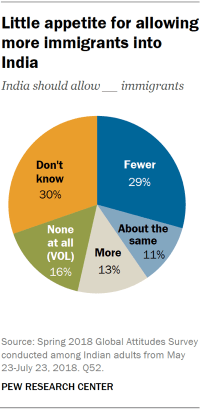
When asked if people leaving for jobs in other countries posed a problem for India, more than six-in-ten (64%) said this type of emigration was a problem, including nearly half (49%) saying it is a very big problem. Although outmigration itself may not be viewed favorably, in 2016 Indian migrants abroad collectively sent nearly $63 billion worth of remittances back to family and friends living in India, or roughly 3% of total gross domestic product.
At the same time, Indians show little enthusiasm for expanding immigration into their country. Roughly three-in-ten Indians (29%) say their government should allow fewer immigrants, with an additional 16% volunteering that there should be no immigration at all.
Just 13% think more immigration into India should be encouraged, and 11% think immigration levels should stay about the same as they are now. In 2017, just over 5 million people (or less than 1% of the population) living in India were born in other countries, with most of them coming from neighboring Bangladesh, Pakistan and Nepal.
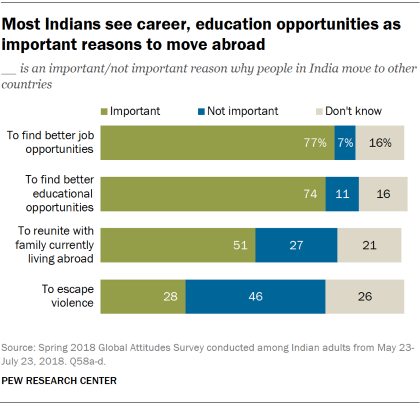
When thinking about why people move abroad, Indians say it is to advance careers and pursue educational opportunities. Roughly three-quarters think finding better jobs and furthering education are important reasons why people in India move to other countries. Roughly half see uniting with family living in another country as an important reason why Indians relocate abroad, while only about a quarter think Indians move to escape violence.
More than eight-in-ten Indians with higher incomes and educational attainment cite the pursuit of better career and education opportunities as reasons people move to other countries, while fewer cite fleeing violence or joining family abroad. Indians in both urban and rural areas also see following better prospects for learning and working abroad as important reasons people in India emigrate.
India-Pakistan relations
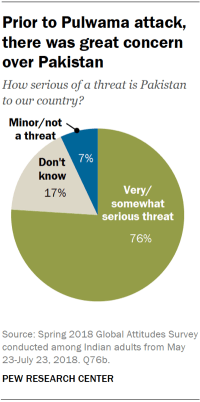
Most Indians see Pakistan, their neighbor to the west, as a threat. When asked how serious of a danger Pakistan poses for India, about three-quarters in India (76%) say Pakistan is a threat, including 63% who say it is a very serious threat. Only 7% of Indians do not see Pakistan as a danger for their country. (This survey was conducted roughly nine months prior to the Pulwama attack, later claimed by Pakistan-based terrorist group Jaish-e-Mohammad, and retaliatory Indian air strikes in Pakistani territory.)
Indians from many walks of life share in this sentiment. Those in rural areas and urban centers, supporters of the prime minister’s BJP and supporters of the opposition Congress party, as well as Indians across age groups, all agree that Pakistan threatens their nation.
Indians who express confidence in Narendra Modi are more likely (70%) to see Pakistan as a threat than are those with less confidence in the prime minister, although even among this latter group about half view Pakistan as a danger (51%).
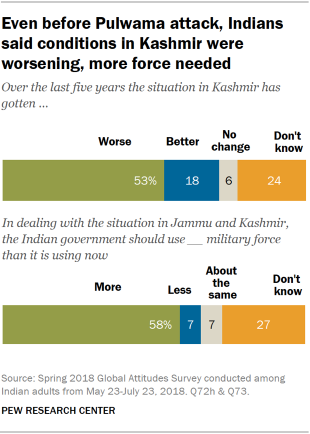
One source of historical tensions between these two nations lies in Kashmir, a region in the Indian subcontinent whose possession has been disputed since the Partition of India – the creation of the modern Indian and Pakistani states – in 1947.
A majority of Indians (55%) see the situation in Kashmir as a very big problem. When asked how this issue has changed over the past five years, more than half (53%) say circumstances in Kashmir have gotten worse. Only 18% think things have gotten better, and just 6% believe conditions are the same.
When asked about the government’s strategy in dealing with the situation in the Indian state of Jammu and Kashmir, a majority believes the Indian government should use more military force than they are currently using. Equal, though small, shares think the military should use either less or about the same amount of force (both 7%).
Global views of India
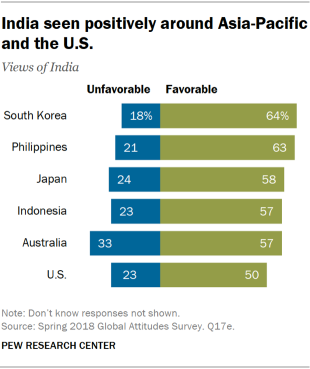
Throughout Prime Minister Narendra Modi’s term in office, international perceptions of India have been mostly positive. Majorities in all five Asia-Pacific countries surveyed have a favorable view of India, with such positive judgement ranging from 64% in South Korea to 57% in Indonesia and Australia. Half the American public also shares this upbeat opinion of the world’s largest democracy.
Compared with 2014, the year Modi first came to office as prime minister, views of India abroad have largely remained stable. Favorable views have increased by a negligible 5 percentage points in South Korea, while they have decreased by the same amount in Japan, Indonesia and the U.S. The Philippines holds more positive views today than four years ago, with a 13-point increase in Indian favorability over that time.
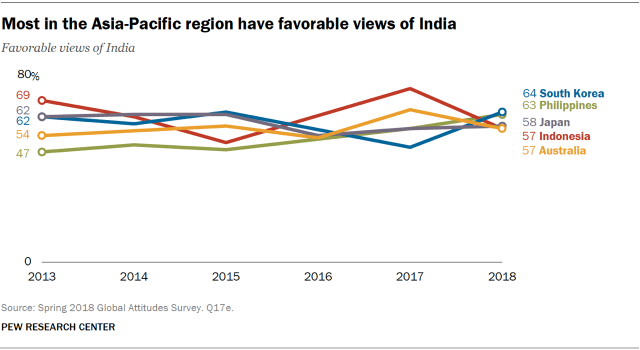
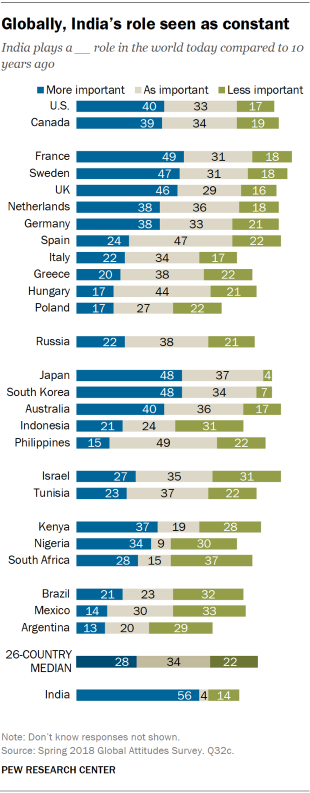
There is a notable gap between how Indians see their country’s global stature and how others around the world see it. While 56% of Indians believe their country is playing a bigger role in world affairs than a decade ago, a median of just 28% across 26 nations polled agree. Pluralities in six countries believe India’s role has grown over the past 10 years, with notable shares saying India’s stature has increased in advanced economies, including France (49%), Japan (48%), South Korea (48%), Sweden (47%) and the UK (46%).
Fewer (a median of 22%) think India’s global role has diminished in the past decade. In particular, South Africans (37%) and Brazilians (32%) see India as a less important global power. The most common view across the nations surveyed (a median of 34%) is that India’s role is about the same as it was 10 years ago.
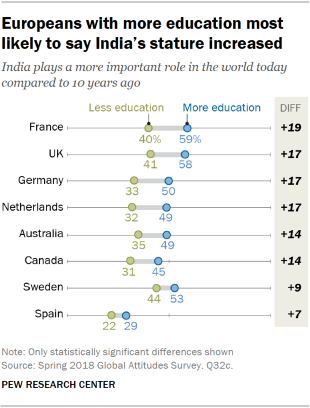
In many European countries, people with higher levels of education and income are more likely to think India plays a larger role today than it did 10 years ago. For example, roughly six-in-ten in France (59%) and the UK (58%) with a postsecondary degree or more say India’s power has grown, compared with about four-in-ten of those with less education.
Views of India’s relatively stagnant role on the world stage compared with 10 years ago diverge from international evaluations of China – a median of 70% in 25 countries say Beijing is playing a more important role in world affairs than 10 years prior. (For more comparisons between countries, see Chapter 3 of “Trump’s International Ratings Remain Low, Especially Among Key Allies.”)
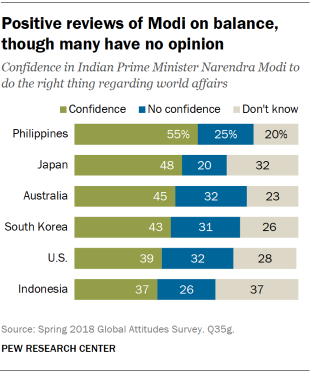
Across the Asia-Pacific region, as well as in the U.S., the share of the public who express confidence in Indian Prime Minister Narendra Modi exceeds the share who lack confidence in him. A majority in the Philippines give the leader a vote of confidence for his handling of world affairs, as do more than four-in-ten in Japan, Australia and South Korea.
The U.S. shows some division in perceptions of the Indian prime minister, with slightly more of the public saying they have confidence in Modi than do not (39% vs. 32%, respectively).
More than a third of Indonesians (37%) express confidence in Modi, though an equal proportion offer no opinion. Roughly a quarter (26%) have no confidence. (Find more about confidence in global leaders from the 2018 Global Attitudes Survey.)




